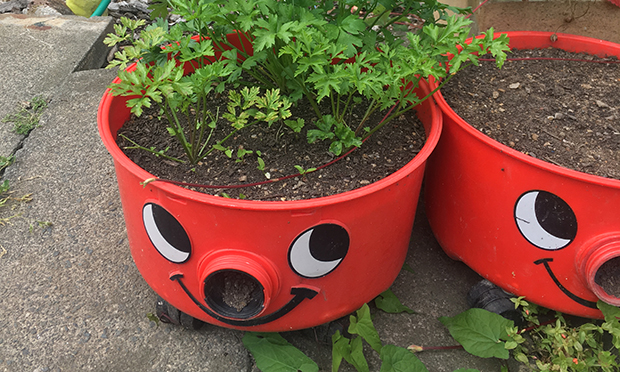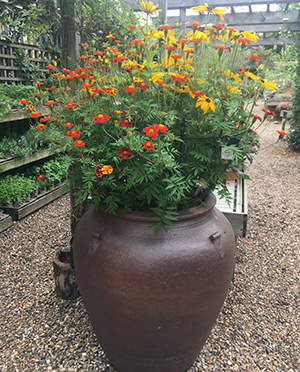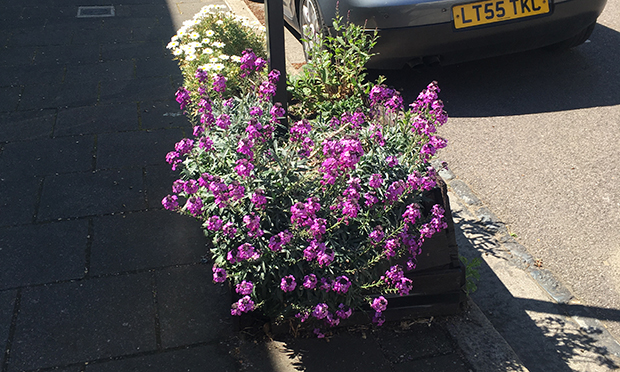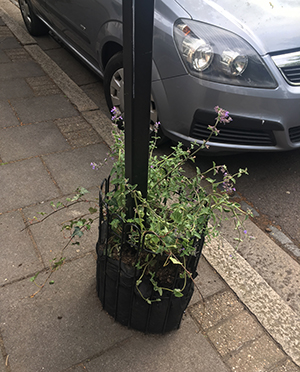The Citizen Gardener: ‘In nature, plants look after themselves, but people can forget, go away, or just give up’

No matter what the bigger picture looks like, at this time of year we can focus on the small-scale – sow seeds and plan for the longer, warmer days which are pretty sure to come.
This past year, as I’ve been working as the E5 postcode gardener, I’ve been observing what grows best in the streets and small spaces that most people have – and also what need least care.
I have come up with a list of plants that have done well (or at least survived) in some of the harshest conditions: pots, balconies and tree pits and that are also good for wildlife.
Growing in Containers

I’ve said this before, but growing in containers is the hardest sort of gardening game because you (as the godlike sub coming onto the pitch in the place of nature) have to provide the food, light and water that the plants in pots will lack – not straight away, but a few weeks after you’ve planted them.
In nature, plants will look after themselves but you are likely to forget, go away, misunderstand the plant’s needs or simply give up (often because you feel you’ve failed).
Growing in Tree Pits
The areas below trees are popular with dogs and the soil is most likely compacted, which is the worst condition for a plant, which needs air in the soil for its roots to take up water and nutrients.
It will also lack water even if not compacted because the tree will take most of that.
The tree’s canopy will make the growing site shady of course.
There are some heroic plants which will grow in these difficult condition, such as ivy, periwinkle and grass.
An alternative that’s been successfully tried in the E5 area is planting round street furniture – such as parking signs.
As long as your planting doesn’t obscure the sign or cause a trip hazard, it should be fine with the authorities.

Growing on Balconies
On balconies you will generally have more light than down on the ground, but will be affected by aspect – the direction your balcony faces and the amount of sun it gets.
Most people long for a south-facing aspect as it gets the most sun, but that can be scorching, especially with hotter summers, the drying effect of more wind and your plants’ inability to draw water from soil.
An east- facing site will give your plants morning sun and is generally cooler than a west-facing site which benefits from the accumulated heat of the day.
If you want to grow soft or tender fruit, like apricots or grape vines, west-facing is good. But even north-facing can be OK as your plants will still get light; some prefer the diffuse light of a northern aspect.
I grow a fantastic daphne in my north-facing spot. It flowers from January to March and has a heavenly scent.

What Plants Need
Plants in pots need good drainage. Your plant is just as likely (if not more) to die from over-watering and waterlogging than drought. You need to prepare for both – free-draining but moisture- retentive. Make sure there are holes in the bottom and that you put a few broken bits of ceramic or gravel in the bottom.
It’s also worth adding anything that will help retain moisture without waterlogging.
Perlite and vermiculite are made from volcanic rock and minerals and hold on to water.
In the summer, place your pot on a saucer or plate as a drip tray so water doesn’t disappear. Putting a layer of gravel, bark or compost on the top of your pot will also stop it losing too much water.
As a rule of thumb, your soil should usually be moist.
In the summer, I water every couple of days, though some plants, like lavender are more drought-tolerant.
The compost or soil you use will affect your plant’s growth and you should replenish it every year.
Whatever you do, DON’T use peat. Although it is widely available in garden centres – indeed, most bags of compost still contain peat so check the label carefully – it comes from an endangered habitat and one which holds huge amounts of carbon. The more that is dug up, the more carbon is being released. And we know what that leads to.
There are plenty of alternatives and I’ve never had any problem with them.
Fertilisers
Soil is a complex living thing and growing in pots depletes that complexity so you might have to supplement your growing medium with food for your plants (something you shouldn’t need to do if growing in the ground).
Of the dozen or so essential plant nutrients and microorganisms needed, there are three that are required in the biggest amounts: nitrogen (N) for leafy growth, potassium (K) for flowers and fruits, and phosphates (P) for seed production and roots.
I wouldn’t recommend using artificial fertilisers (they are finite). There are organic (as in derived from something once living) alternatives.
For plants needing a lot of nitrogen, use animal manure (horse, cow, chicken – available from city farms). Don’t use fresh; it needs to rot for a year or so. For K, liquid seaweed, wood ash and bat manure (!) are good, and bone-meal is high in phosphates.
For vegans (and everyone), making your own comfrey compost/tea gives plants a powerful boost and will provide the necessary nutrients.
Feed your pots with comfrey tea – just add leaves to water and let it rot and really really stink.
For slower-release and less smelly fertiliser you can just dig the leaves into your soil – or even lay them on top – and they will break down over time.
It’s worth growing some comfrey in a pot. It has bee-attracting flowers.
I don’t usually bother using fertiliser at all unless I’m growing vegetables or heavily floriferous plants.
I top up my pots with home-made compost or repot the plants every year and that seems to do.
Here are a few low maintenance plants that have done well in E5 in pots and are good for wildlife:
Perennials that do well in containers:
Salvia/sage, lavender, geranium/cranesbill (not pelargonium. I’ve never seen an insect on one), hesperis matronalis, potentilla, aster sedum/stonecrop, Californian poppy, euphorbia, hellebore, heuchera, nepeta, ivy, scabious, dahlia (open-petalled varieties), verbena bonariensis, crocus, yarrow, fennel, perennial wallflower (erysimum), chives, mint, thyme, marjoram/oregano, lemon balm, lamium/dead nettle, everlasting sweet pea.
Annuals/self-seeders for cracks and colour:
Red valerian (good for a south- facing balcony), alyssum, Mexican fleabane, forget-me-not, pot marigold (simple flowers), nasturtium, daisy, bellflower (campanula), ivy leaved toadflax, yellow corydalis, love-in-a-mist (nigella), wallflowers, evening primrose, rocket.
Good for ground cover (around trees for example):
Scarlet pimpernel, lesser celandine (likes damp), ivy, wood sorrel/oxalis, sweet violet, periwinkle.
Kate Poland is an award-winning community gardener and the UK’s first ever postcode gardener in E5. For more, head to cordwainersgrow.org.uk and friendsoftheearth.uk
